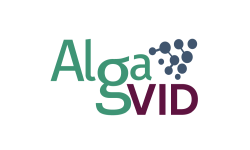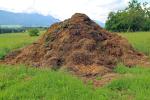
ALGAVID Operational Group: Digitalization of the effect produced by biostimulants and soil bioregenerators based on microALGAe, produced in the same facility as the farmer
- Type Operational group
- Status Filled
- Execution 2023 -2025
- Assigned Budget 599.883,57 €
- Scope Supraautonómico
- Autonomous community Andalucía; Aragón; Castilla - La Mancha; Cataluña
- Main source of financing CAP 2014-2020
- Project website https://algavid.grupooperativo.es
A protocol has been developed for the implementation and monitoring of microalgae cultivation, thus ensuring their autonomous growth and reproduction using photobioreactors installed on various farms. This system enables efficient and sustainable microalgae production, adapted to the specific characteristics of each agricultural environment. At Viñedos del Río Tajo, photobioreactors with a total capacity of 2,300 liters have been installed, while at Bodegas Robles, a company specializing in organic dryland farming, a 300-liter system has been implemented. A stable consortium of Chlorella sorokiniana and Scenedesmus costatus has been successfully developed, adapted to the unique conditions of each farm and capable of self-sustaining over time. Furthermore, operators have been trained in the proper use of the photobioreactors, incorporating their feedback to optimize system performance according to identified needs. Throughout the process, strategies have been devised to reuse excess microalgae, applying them to various vineyard applications, such as treating diseased vines or improving root development. Complete operating manuals have been developed to ensure the system's proper implementation. Furthermore, the microalgae's adaptation to different environmental conditions was evaluated, revealing variations in both ecosystems due to interactions with native microorganisms.
A Decision Support System (DSS) has been developed to integrate data collected by field sensors and external sources, facilitating efficient and simple agronomic and environmental decision-making. The system enables data collection, storage, and transmission using autonomous, solar-powered devices, ensuring uninterrupted operation even in adverse conditions. Communication is via LTE modems that transmit information to a central server. Advanced sensors have been implemented to monitor critical parameters such as soil moisture, temperature, electrical conductivity, pH, and weather conditions. In addition, experimental validation has been performed for the development of an NPK sensor by characterizing synthetic samples in various spectral ranges. A cloud platform has been implemented that integrates external data from sources such as AEMET using ETL algorithms and APIs to ensure efficient data management. The DSS allows data visualization through interactive graphs, with options to export results as images or data tables. The system also calculates the daily thermal integral, a key metric for predicting critical stages of the vine's phenological cycle and optimizing vineyard management.
A system has been developed to optimize the production of microalgae-based biostimulants, with the goal of maximizing efficiency and quality. This system incorporates anomaly detection, alert management, and automated recommendation generation to continuously optimize the production process. The anomaly detection module verifies each sensor measurement to ensure it falls within expected ranges, identifying and recording potential failures or errors. Additionally, a data loss control module has been implemented to periodically monitor data transmission, ensuring uninterrupted process continuity. Submodules for defining actions and a recommendation master have also been developed, allowing customized actions to be configured based on specific field conditions. These recommendations include fertilizer application adjustments, pH correction, and microalgae irrigation modifications.
A novel microalgal consortium composed of Chlorella sorokiniana and Scenedesmus costatus has been developed to produce cost-effective and sustainable agricultural biostimulants and soil bioremediators. This combination was selected for its adaptability to diverse environmental conditions and its proven efficacy in improving crop health and soil quality. The optimization process involved ecosystem stabilization, performance evaluation under various environmental conditions, and adaptation to the specific requirements of each vineyard. Furthermore, comprehensive protocols for the preparation, handling, and application of the biostimulants have been established, ensuring ease of use by operators and consistent efficacy across diverse agricultural scenarios. The efficacy of the microalgal consortium has been validated through its ability to enhance plant rooting and rehabilitate soils with specific deficiencies. Its long-term stability and adaptability to changing environmental conditions have also been successfully demonstrated.
An agronomic platform has been developed that incorporates a decision support system (DSS) with voice interaction for ease of use and accessibility. This system allows users to consult information, receive recommendations, and navigate through the platform's different modules using voice commands. The voice interaction module includes advanced voice recognition and recommendation issuance features through a virtual assistant. This assistant allows quick and intuitive access to different platform modules, such as data visualization, graph viewing, receiving alerts and recommendations, and accessing satellite images. Voice navigation improves the user experience by offering efficient access without the need for manual interaction. The system allows users to directly hear the alerts and recommendations generated by the platform and navigate between modules using voice commands, facilitating the retrieval of relevant information and improving accessibility.
An economic analysis of microalgae application in vineyards was conducted, evaluating its impact on soil fertility, biodiversity, and waste generation. This evaluation compared microalgae-treated plots with control plots subjected to conventional fertilization. The results demonstrate that microalgae application improves soil organic matter, thereby improving its quality and fertility. Furthermore, microalgae have demonstrated a progressive and sustainable improvement in soil structure, with long-term cumulative positive effects. From an economic perspective, the implementation of the system has achieved a 20% reduction in fertilizer use, significantly improving resource efficiency and reducing costs. Furthermore, the integration of microalgae has proven compatible with sustainable agricultural practices, reducing dependence on chemical inputs. Furthermore, the application of microalgae in an area affected by iron chlorosis produced significant improvements compared to untreated areas, highlighting its potential effectiveness in mitigating this deficiency.
As part of this project, the feasibility of approving the use of microalgae in organic farming has been examined, with the involvement of experts throughout the process. This study is particularly relevant since Common Agricultural Policy (CAP) data indicate that organic production in irrigated woody crops is significantly behind that of irrigated crops. The application of microalgae offers notable benefits in terms of natural fertilization and improved plant health, which contributes to reducing dependence on plant protection products. However, the approval of microalgae as a fertilizer or biostimulant is not currently recognized by European organic farming regulations. Since microalgae are not included in the coding of active substances, their approval would require specific studies and a regulatory process at both the European and multi-crop levels. In response to these regulatory limitations, the use of microalgae under the commercial label "Compatible with Organic Farming" is proposed, rather than seeking formal approval. This compatibility is based on the fact that microalgae are a Nature-Based Solution (NBS) whose application avoids the use of synthetic agrochemicals, thus aligning with the principles of organic production.
The potential of microalgae for CO2 capture in irrigated crops has been evaluated, recognizing their contribution despite the complexity of precise quantification. Microalgae capture CO2 from the atmosphere through photosynthesis. In fertigation, they provide approximately 82.44 grams of biomass per 1,000 liters of irrigation, resulting in an estimated CO2 saving of 2.95 tons per hectare per year. Furthermore, the replacement of chemical fertilizers contributes to an additional reduction of 672 kg of CO2 per year. When combined, these factors result in a total estimated reduction of 1.9 tons of CO2 equivalents per hectare per year. This reduction corresponds to an approximate economic value of €60/ha per year, assuming a carbon credit price of €30 per ton. Furthermore, microalgae application improves soil organic matter (SOM) by introducing beneficial microorganisms. Trials have shown an average increase in SOM of 2.1% compared to control plots. However, factors such as climate, soil type, topography, and agricultural management practices make precise quantification difficult. CO2 capture is measured in situ as a result of general crop management practices, not solely through applied inputs. Therefore, it is advisable to associate this microalgae-based solution with improved CO2 capture without specifying exact values. The proposed marketing positioning statement is: "The application of microalgae as biostimulants contributes to improved CO2 capture in the soil."
Act. O1 RD 1. AD1. Project launch
This activity was developed and completed during the first period of the project. Its objective was to create a communications plan and corporate image for the project, as well as its website and main social media platforms, to ensure its visibility.
In summary, a schematic list of all resources created during the previous period is presented:
- Communication Plan
- Visual identity: Logo; Logo adaptations; Fonts; Poster examples.
- Website
- Social networks: LinkedIn; Facebook
Act. O2 RD2 AD2. Positioning and dissemination
WEB STATS: Last year alone (February 24/25, Google Analytics):
- 1316 views
- 417 users
- 42 seconds of interaction
SOCIAL NETWORK STATISTICS:
- Facebook: 624 views / 524 different people / 31 posts.
- LinkedIn: 12,787 impressions / 337 reactions / 30 posts
EVENTS:
List of specialized media:
- Interview in television studios
- AGROSFERA RTVE Program
- ONDA CERO Interview
- HERE IS WORK Program
- Specialized magazine AGRICULTURAL NOTEBOOK
Attendance at events:
- AGROTECH FORUM IA: 09/11/2023
- AGROVID FAIR: 05-07/03/2024
- SMART AGRIFOOD SUMMIT CONGRESS: 03/14-15/2024
- VINOBLE FAIR: 26-28/05/2024
- EXPO AGRITECH CONGRESS: 26-28/11/2024
- VIMAR TRADE FAIR: 25-27/11/2024
- EMPLOYABILITY DAY. ETSIA. 18/02/2025
Act. O3 RD3 AD3. Exploitation of results.
- The exploitation of the results of this project is based on the holding of demonstration days.
1st Demonstration Day for Young Farmers. May 21-22, 2024 - 2nd Demonstration Day for the Entire Agricultural and Food Sector. January 31, 2025
- Webinar: Microalgae Fertigation: A Cost-Effective, Viable, and Environmentally Friendly Solution. February 21, 2025
- 3rd Demonstration Day. Final Day. February 26, 2025. Recommended.
The overall objective of the project is to develop an advanced decision-support system and issue recommendations in the agricultural sector for the dosage of microalgae-based biostimulants, fertilizers, and soil amendments incorporated into microalgae and water from irrigation canals, wells, etc., with their specific characteristics.
To this end, the implementation of sensors and the development of new data generation and capture systems are proposed, allowing for the real-time measurement of new magnitudes not previously taken into account in agricultural production, such as soil porosity, temperature at a depth of 10-15-20 cm and CO2 absorption capacity, as well as other well-known magnitudes such as pH, NPK, EC, etc., among others, which favor the optimization of the aforementioned resources and maximize crop production and quality.
After a preparation phase of the data obtained through sensor technology, which highlights the automatic detection and correction of measurement errors, predictive algorithms will be used to generate recommendations for actions to be taken regarding irrigation timing or products to be applied, with the aim of improving soil productivity while preserving its value, improving the quality of the product obtained, and reducing the application of chemicals.
- Protocol for the implementation and monitoring of microalgae cultivation systems.
- Decision support system for determining agronomic and environmental monitoring services. Obtaining a new mix of low-cost, environmentally friendly agricultural biostimulants and soil bioremediators.
- User-friendly agronomic platform with voice-based decision support.
- Economic assessment of the solution, as well as its effect on soil, biodiversity, waste, and CO2 quantification. Recommendations for obtaining organic certification by incorporating the new program for fertilization management and irrigation control.
- Protocol for the implementation and monitoring of microalgae cultivation systems.
- Decision support system for determining agronomic and environmental monitoring services. Obtaining a new mix of low-cost, environmentally friendly agricultural biostimulants and soil bioremediators.
- User-friendly agronomic platform with voice-based decision support.
- Economic assessment of the solution, as well as its effect on soil, biodiversity, waste, and CO2 quantification. Recommendations for obtaining organic certification by incorporating the new program for fertilization management and irrigation control.
- Coordinator/entity name: fundacionayesa
- Coordinator/entity email: info@fundacionayesa.org
- Fundación AYESA
- Bodegas Robles SA
- Pilar Pedraza Ferrández
- Cooperativas Agro-alimentarias de Andalucía
- Grow to Grow Algae solutions S.L.
- Acondicionamiento Tarrasense
- Bodega Las Copas S.L
- Fundación Agroecosistema





